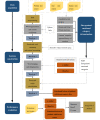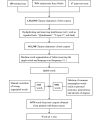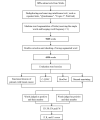Construction of an Emotional Lexicon of Patients With Breast Cancer: Development and Sentiment Analysis
- PMID: 37698914
- PMCID: PMC10523220
- DOI: 10.2196/44897
Construction of an Emotional Lexicon of Patients With Breast Cancer: Development and Sentiment Analysis
Abstract
Background: The innovative method of sentiment analysis based on an emotional lexicon shows prominent advantages in capturing emotional information, such as individual attitudes, experiences, and needs, which provides a new perspective and method for emotion recognition and management for patients with breast cancer (BC). However, at present, sentiment analysis in the field of BC is limited, and there is no emotional lexicon for this field. Therefore, it is necessary to construct an emotional lexicon that conforms to the characteristics of patients with BC so as to provide a new tool for accurate identification and analysis of the patients' emotions and a new method for their personalized emotion management.
Objective: This study aimed to construct an emotional lexicon of patients with BC.
Methods: Emotional words were obtained by merging the words in 2 general sentiment lexicons, the Chinese Linguistic Inquiry and Word Count (C-LIWC) and HowNet, and the words in text corpora acquired from patients with BC via Weibo, semistructured interviews, and expressive writing. The lexicon was constructed using manual annotation and classification under the guidance of Russell's valence-arousal space. Ekman's basic emotional categories, Lazarus' cognitive appraisal theory of emotion, and a qualitative text analysis based on the text corpora of patients with BC were combined to determine the fine-grained emotional categories of the lexicon we constructed. Precision, recall, and the F1-score were used to evaluate the lexicon's performance.
Results: The text corpora collected from patients in different stages of BC included 150 written materials, 17 interviews, and 6689 original posts and comments from Weibo, with a total of 1,923,593 Chinese characters. The emotional lexicon of patients with BC contained 9357 words and covered 8 fine-grained emotional categories: joy, anger, sadness, fear, disgust, surprise, somatic symptoms, and BC terminology. Experimental results showed that precision, recall, and the F1-score of positive emotional words were 98.42%, 99.73%, and 99.07%, respectively, and those of negative emotional words were 99.73%, 98.38%, and 99.05%, respectively, which all significantly outperformed the C-LIWC and HowNet.
Conclusions: The emotional lexicon with fine-grained emotional categories conforms to the characteristics of patients with BC. Its performance related to identifying and classifying domain-specific emotional words in BC is better compared to the C-LIWC and HowNet. This lexicon not only provides a new tool for sentiment analysis in the field of BC but also provides a new perspective for recognizing the specific emotional state and needs of patients with BC and formulating tailored emotional management plans.
Keywords: breast cancer; domain emotional lexicon; lexicon construction; natural language processing; sentiment analysis.
©Chaixiu Li, Jiaqi Fu, Jie Lai, Lijun Sun, Chunlan Zhou, Wenji Li, Biao Jian, Shisi Deng, Yujie Zhang, Zihan Guo, Yusheng Liu, Yanni Zhou, Shihui Xie, Mingyue Hou, Ru Wang, Qinjie Chen, Yanni Wu. Originally published in the Journal of Medical Internet Research (https://www.jmir.org), 12.09.2023.
Conflict of interest statement
Conflicts of Interest: None declared.
Figures




Similar articles
-
Differing Content and Language Based on Poster-Patient Relationships on the Chinese Social Media Platform Weibo: Text Classification, Sentiment Analysis, and Topic Modeling of Posts on Breast Cancer.JMIR Cancer. 2024 May 9;10:e51332. doi: 10.2196/51332. JMIR Cancer. 2024. PMID: 38723250 Free PMC article.
-
China public emotion analysis under normalization of COVID-19 epidemic: Using Sina Weibo.Front Psychol. 2023 Jan 9;13:1066628. doi: 10.3389/fpsyg.2022.1066628. eCollection 2022. Front Psychol. 2023. PMID: 36698592 Free PMC article.
-
Determination of Patient Sentiment and Emotion in Ophthalmology: Infoveillance Tutorial on Web-Based Health Forum Discussions.J Med Internet Res. 2021 May 17;23(5):e20803. doi: 10.2196/20803. J Med Internet Res. 2021. PMID: 33999001 Free PMC article.
-
Sentiment Analysis of Patient- and Family-Related Sepsis Events: Exploratory Study.JMIR Nurs. 2024 Apr 1;7:e51720. doi: 10.2196/51720. JMIR Nurs. 2024. PMID: 38557694 Free PMC article.
-
Advancements and challenges in Arabic sentiment analysis: A decade of methodologies, applications, and resource development.Heliyon. 2024 Oct 24;10(21):e39786. doi: 10.1016/j.heliyon.2024.e39786. eCollection 2024 Nov 15. Heliyon. 2024. PMID: 39553679 Free PMC article. Review.
Cited by
-
Leveraging BiLSTM-CRF and adversarial training for sentiment analysis in nature-based digital interventions: Enhancing mental well-being through MOOC platforms.Digit Health. 2025 Feb 18;11:20552076251317345. doi: 10.1177/20552076251317345. eCollection 2025 Jan-Dec. Digit Health. 2025. PMID: 39974759 Free PMC article.
-
Detection of differences in physical symptoms between depressed and undepressed patients with breast cancer: a study using K-medoids clustering.BMC Cancer. 2025 Jan 7;25(1):23. doi: 10.1186/s12885-024-13387-z. BMC Cancer. 2025. PMID: 39773474 Free PMC article.
-
Deep parallel contextual analysis framework based emotion prediction in community wellness communications on social media.Heliyon. 2024 May 21;10(11):e31626. doi: 10.1016/j.heliyon.2024.e31626. eCollection 2024 Jun 15. Heliyon. 2024. PMID: 38841475 Free PMC article.
-
Construction of a transfer learning-based depression detection model for female breast cancer patients: text sentiment analysis.BMC Cancer. 2025 Aug 12;25(1):1307. doi: 10.1186/s12885-025-14650-7. BMC Cancer. 2025. PMID: 40797296 Free PMC article.
-
The Influence of Cognitive and Emotional Factors on Social Media Users' Information-Sharing Behaviours during Crises: The Moderating Role of the Construal Level and the Mediating Role of the Emotional Response.Behav Sci (Basel). 2024 Jun 12;14(6):495. doi: 10.3390/bs14060495. Behav Sci (Basel). 2024. PMID: 38920827 Free PMC article.
References
-
- Latest global cancer data: cancer burden rises to 19.3 million new cases and 10.0 million cancer deaths in 2020. International Agency for Research on Cancer. 2020. Dec 15, [2023-08-21]. https://www.iarc.who.int/news-events/latest-global-cancer-data-cancer-b...
-
- Fortin J, Leblanc M, Elgbeili G, Cordova MJ, Marin M, Brunet A. The mental health impacts of receiving a breast cancer diagnosis: a meta-analysis. Br J Cancer. 2021 Nov 04;125(11):1582–1592. doi: 10.1038/s41416-021-01542-3. https://europepmc.org/abstract/MED/34482373 10.1038/s41416-021-01542-3 - DOI - PMC - PubMed
-
- Holmes C, Jackson A, Looby J, Gallo K, Blakely K. Breast cancer and body image: feminist therapy principles and interventions. J Fem Fam Ther. 2021 Jan 21;33(1):20–39. doi: 10.1080/08952833.2021.1872266. - DOI
Publication types
MeSH terms
LinkOut - more resources
Full Text Sources
Medical

